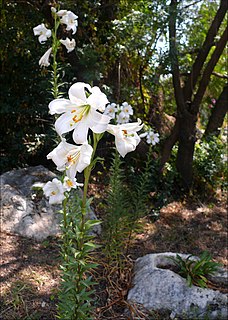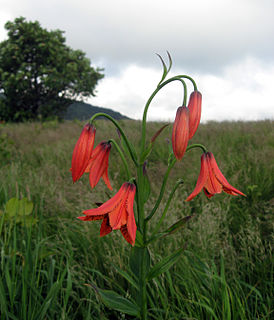
Lilium is a genus of herbaceous flowering plants growing from bulbs, all with large prominent flowers. They are the true lilies. Lilies are a group of flowering plants which are important in culture and literature in much of the world. Most species are native to the temperate northern hemisphere, though their range extends into the northern subtropics. Many other plants have "lily" in their common names, but do not belong to the same genus and are therefore not true lilies.

Lilium bulbiferum, common names orange lily, fire lily,Jimmy's Bane and tiger lily, is a herbaceous European lily with underground bulbs, belonging to the Liliaceae.

Lilium candidum, the Madonna lily, or white lily is a plant in the true lily family. It is native to the Balkans and Middle East, and naturalized in other parts of Europe, including France, Italy, and Ukraine, and in North Africa, the Canary Islands, Mexico, and other regions. It has been cultivated since antiquity, for at least 3,000 years, and has great symbolic value since then for many cultures. It is susceptible to several virus diseases common to lilies, and especially to Botrytis fungus. One technique to avoid problems with viruses is to grow plants from seed instead of bulblets.

Lilium philadelphicum, also known as the wood lily, Philadelphia lily, prairie lily, or western red lily, is a perennial species of lily native to North America.

Lilium martagon, the martagon lily or Turk's cap lily, is a Eurasian species of lily. It has a widespread native region extending from Portugal east through Europe and Asia as far east as Mongolia.

Cardiocrinum is a genus of bulbous plants of the lily family first described in 1846. They are native to the Himalaya, China, the Russian Far East, and Japan. The bulbs are usually formed at the soil surface. The preferred habitat is woodland. The plants tend to be monocarpic, dying after flowering.

Lilium canadense, commonly called either the Canada lily, wild yellow-lily, or the meadow lily, is a native of eastern North America. Its native range extends from Ontario to Nova Scotia south to Georgia and Alabama. It is most common in New England, the Appalachian Mountains, and the Canadian Maritimes. It is also cultivated as an ornamental in Europe and other places.

Arum is a genus of flowering plants in the family Araceae, native to Europe, northern Africa, and western and central Asia, with the highest species diversity in the Mediterranean region. Frequently called arum lilies, they are not closely related to the true lilies Lilium. Plants in closely related Zantedeschia are also called "arum lilies".

Lilium davidii is an Asian species of plants in the lily family, native to mountainous areas of Assam, Manipur, Arunachal Pradesh, Tibet, Bhutan, Hubei, Shaanxi, Sichuan, Guizhou, and Yunnan.

Lilium carniolicum, commonly called golden apple or Carniolan lily, is a lily native to the Balkans, as well as to Austria and northeastern Italy. The species is named after the historical region Carniola, comprising parts of modern-day Slovenia, where it is most abundant.

Fritillaria graeca is a European plant species in the lily family Liliaceae. It is native to the Balkans. Some older literature says that the plant can also be found in Serbia, but all these collections are of var. gussichiae, now regarded as a distinct species called Fritillaria gussichiae.

Lilium kelloggii is a species of lily known by the common name Kellogg's lily. It is endemic to the Klamath Mountains of northwestern California and southwestern Oregon, where it grows in forests, including those dominated by redwoods.

Lilium parryi, common name lemon lily, is a rare species of lily.

Lilium pumilum is an Asian species of bulbous plants native to Mongolia, Siberia, the Russian Far East, Korea and northern China.

Lilium grayi is a perennial plant that is endemic to the eastern US states of North Carolina, Virginia, and Tennessee, growing in moist, acid soil in the Appalachian mountains on higher elevation meadows, bogs, and seeps. The plant was introduced to Royal Botanic Gardens, Kew in 1890 and was featured in the Kew Bulletin in 1892.

Lilium pyrophilum, the sandhills lily, is a North American species of plant in the lily family. It is endemic to the Sandhills region of southern Virginia, North Carolina and northern South Carolina, in the eastern United States.

Lilium formosanum, also known as the Formosa lily or Taiwanese lily, is a plant species in the lily family, endemic to Taiwan. It is closely related to the Easter lily found in the Ryukyu Islands of Japan, eastern and northern Taiwan. Both species are cultivated for their showy, trumpet-shaped flowers. Lilium formosanum has become naturalized in scattered locations in Africa, Australia, and the Americas.

Lilium philippinense, commonly known as the Benguet lily, or Philippine lily, is a lily, native to Taiwan and to the Cordillera region, primarily to the province of Benguet, in the northern Philippines.
Gagea ramulosa is a Eurasian and North African plant species in the lily family. It is native to France, Sardinia, Sicily, Greece, Turkey, Libya, Ukraine, European Russia, Caucasus, Syria, Lebanon, Iraq, Iran, and Afghanistan. Some authors consider this to be the same species as G. dubia, but the World Checklist does have it listed as a distinct species.

Lilium polyphyllum is a species of lily endemic to montane environments in central Asia.



















